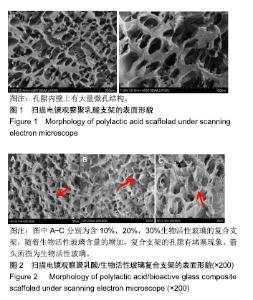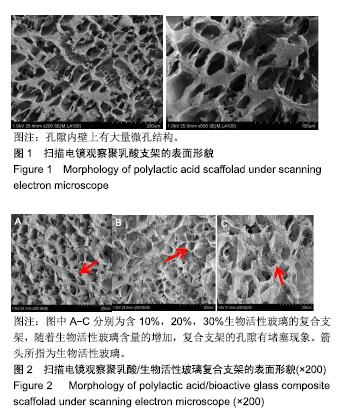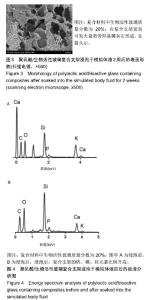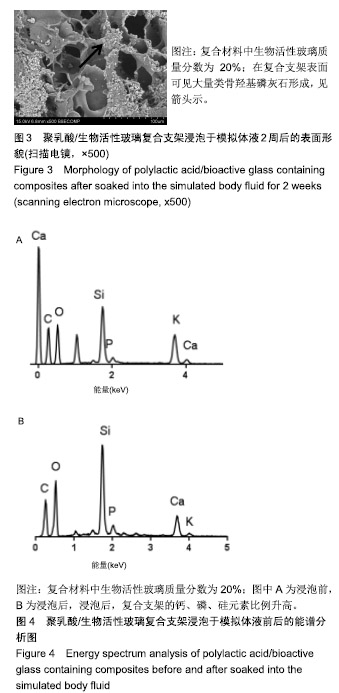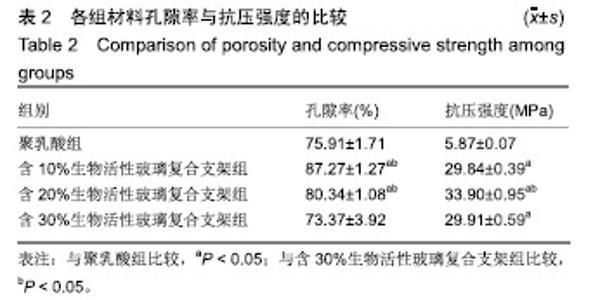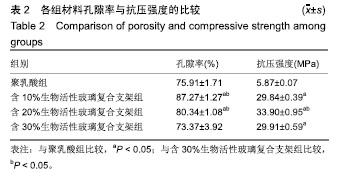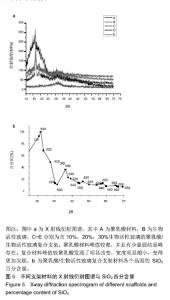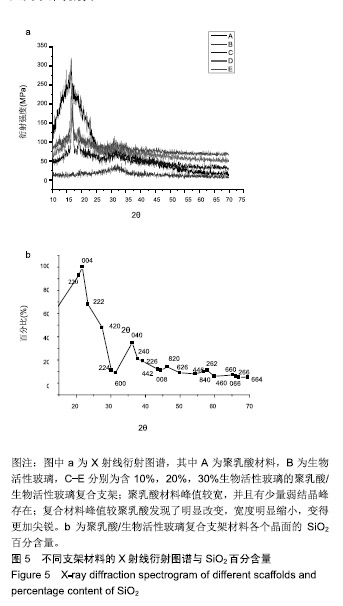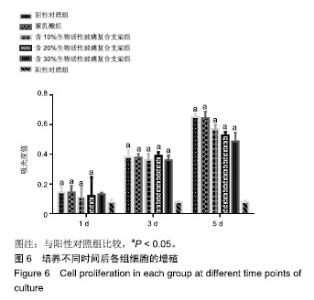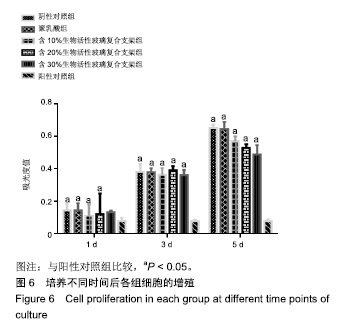| [1]刘相杰,宋科官.生物支架材料及间充质干细胞在骨组织工程中的研究与应用[J].中国组织工程研究,2018,22(10):1618-1624.[2]徐桂文,滕勇.复合型组织工程化人工骨支架:应用进展与未来方向[J].中国组织工程研究,2018, 22(14):2245-2250. [3]李建伟,郭全义,张景春,等.组织工程骨软骨一体化多相支架的制备与体外检测评估[J].中国修复重建外科杂志,2018,32(4):1-7.[4]杜瑞林,倪似愚,常江,等.含Zn生物玻璃、玻璃陶瓷与聚酯复合骨组织工程支架的制备及性能[J].复合材料学报, 2008,25(6): 123-129.[5]Jie W,Cai Y,Shen H,et al.Mesoporous calcium–silicon xerogels with mesopore size and pore volume influence hMSC behaviors by load and sustained release of rhBMP-2.Int J Nanomedicine. 2015;10:1715-1726.[6]Wu Z,Tang T,Guo H,et al.In vitro dejgradability, bioactivity and cell responses to mesoporous magnesium silicate for the induction of bone regeneration.Colloids Surf B Biointerfaces. 2014;120(120):38-46.[7]Zheng K, Lu M, Liu Y,et al.Monodispersed lysozyme-functionalized bioactive glass nanoparticles with antibacterial and anticancer activities.Biomed Mater.2016;11(3):035012.[8]Liu T,Ding X,Lai D,et al.Enhancing in vitro bioactivity and in vivo osteogenesis of organic-inorganic nanofibrous biocomposites with novel bioceramics.J Mater Chem B. 2014;2(37):6293-6305.[9]葛建华,王迎军,陈晓峰.生物活性玻璃/聚乳酸组织工程支架在SBF溶液中的降解和矿化性能[J].复合材料学报, 2011,28(5): 90-93.[10]Eqtesadi S,Motealleh A,Perera FH,et al. Poly-(lactic acid) infiltration of 45S5 Bioglass® robocast scaffolds: Chemical interaction and its deleterious effect in mechanical enhancement.Mater Lett.2016;163:196-200.[11]Mohammadkhah A,Day DE.Mechanical properties of bioactive glass/polymer composite scaffolds for repairing load bearing bones.Int J Appl Glass Sci.2018;9(2):188-197.[12]Eqtesadi S,Motealleh A,Hugo Perera F,et al. Poly-(lactic acid) infiltration of 45S5 Bioglass® robocast scaffolds: Chemical interaction and its deleterious effect in mechanical enhancement. Mater Lett.2016;163(15):196-200.[13]Qazi TH,Mooney DJ,Pumberger M,et al.Biomaterials based strategies for skeletal muscle tissue engineering: existing technologies and future trends.Biomaterials. 2015;53: 502-521.[14]Zhou H,Lee J, Sun F.Various preparation methods of highly porous hydroxyapatite/polymer nanoscale biocomposites forbone regeneration.Acta Biomater.2011;7(11):3813-3828.[15]Wu S, Liu X,Yeung KWK,et al.Biomimetic porous scaffolds for bone tissue engineering.Mater Sci Eng R.2014;80(1):1-36.[16]Fu Q,Saiz E,Rahaman MN,et al.Toward Strong and Tough Glass and Ceramic Scaffolds for Bone Repair. Adv Funct Mater.2013;23(44):5461-5476.[17]Iafisco M,Sandri M,Panseri S,et al.Magnetic Bioactive and Biodegradable Hollow Fe-Doped Hydroxyapatite Coated Poly(L-lactic) Acid Micro-nanospheres.Chem Mater. 2013; 25(13):2610-2617. [18]Locatelli E,Franchini MC.Biodegradable PLGA-b-PEG polymeric nanoparticles: synthesis, properties, and nanomedical applications as drug delivery system.J Nanopart Res.2012;14(12):1316.[19]Zia S,Mozafari M,Natasha G,et al.Hearts beating through decellularized scaffolds: whole-organ engineering for cardiac regeneration and transplantation. Crit Rev Biotechnol. 2016; 36(4):705-715.[20]Zhang C,Mcadams DA,Grunlan JC.Bioinspired Materials: Nano/Micro‐Manufacturing of Bioinspired Materials: a Review of Methods to Mimic Natural Structures.Adv Mater. 2016;28(30):6265-6265.[21]Liu Z,Ji J,Tang S,et al.Biocompatibility, degradability, bioactivity and osteogenesis of mesoporous/macroporous scaffolds of mesoporous diopside/poly(L-lactide) composite.J Royal Soc Interface.2015;12(111):20150507.[22]Wu C,Chen Z,Yi D,et al.Multidirectional Effects of Sr-, Mg-, and Si-Containing Bioceramic Coatings with High Bonding Strength on Inflammation, Osteoclastogenesis, and Osteogenesis.ACS Appl Mater Interfaces. 2014;6(6): 4264-4276.[23]Parizek M,Douglas TE,Novotna K,et al.Nanofibrous poly(lactide-co-glycolide) membranes loaded with diamond nanoparticles as promising substrates for bone tissue engineering. Int J Nanomedicine. 2012;7:1931-1951.[24]Zhong S,Teo WE,Zhu X,et al.An aligned nanofibrous collagen scaffold by electrospinning and its effects on in vitro fibroblast culture.J Biomed Mater Res A. 2010;79A(3):456-463.[25]Aravamudhan A,Ramos DM,Jenkins NA,et al.Collagen nanofibril self-assembly on a natural polymeric material for the osteoinduction of stem cells in vitro and biocompatibility in vivo. RSC Adv.2016; 6(84):80851-80866.[26]Novajra G,Perdika P,Pisano R,et al.Tailoring of Bone Scaffold Properties Using Silicate/Phosphate Glass Mixtures.Key Eng Mater.2015;631:283-288.[27]Novajra G,Perdika P,Pisano R,et al.Structure optimisation and biological evaluation of bone scaffolds prepared by co-sintering of silicate and phosphate glasses.Adv Appl Ceramic. 2015;114(sup1):S48-S55.[28]Gerçek I,Tigli RS,Gümü?derelioglu M.A novel Scaffold Based on Formation and Agglomeration of PCL Microbeads by Freeze-Drying.J Biomed Mater Res A. 2008;86(4):1012-1022. [29]Narayanan G,Gupta BS,Tonelli AE.Enhanced Mechanical properties of Poly (ε-caprolactone) Nanofibers produced by the Addition of Non-stoichiometric Inclusion Complexes of Poly (ε-caprolactone) and α-Cyclodextrin.Polymer. 2015; 75(12):321-330. |
